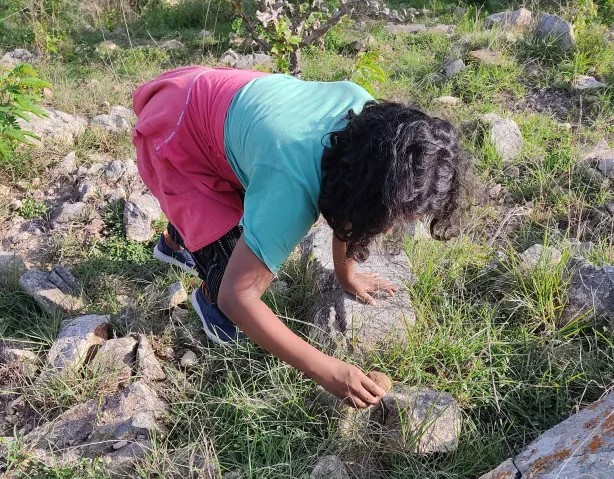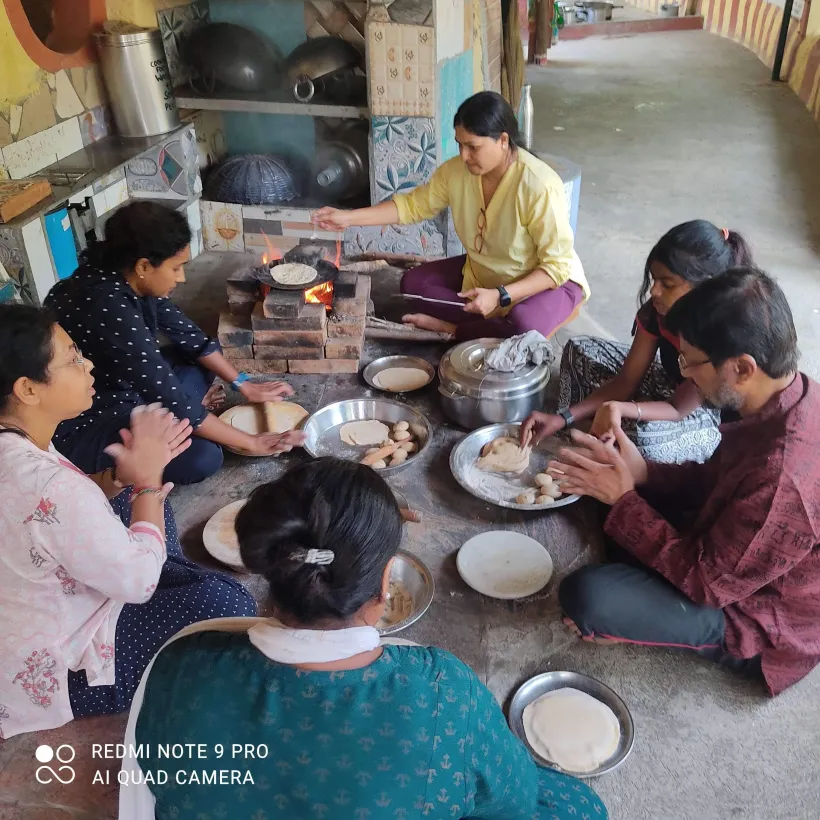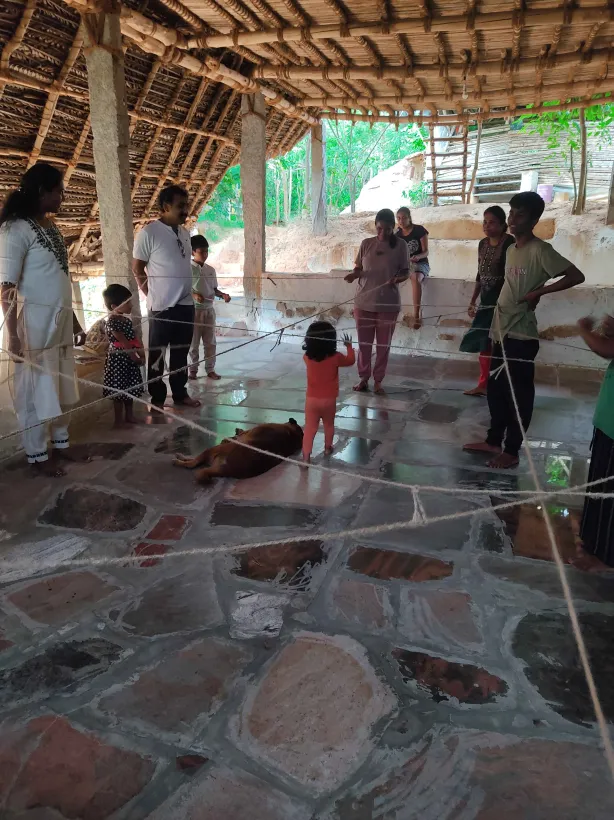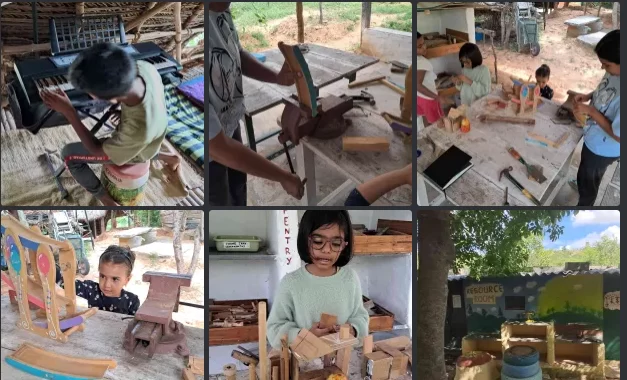Our interaction with our environment shapes us as a person and our learning abilities. We have the power to build an environment which facilitates growth and nurturing. Read further to know about what creates such stimulating environment.
Environmental factors significantly shape our self-perception as learners and our capacity for growth. As we develop, our environment expands, beginning with our family and extending to society at large. Ultimately, it encompasses broader systems and geographical locations. Regardless of age, our environment exerts a profound influence on us in various ways.
The Aarohi community provides numerous nurturing and stimulating opportunities to foster a conducive learning environment. Let’s look at how we can create a nurturing learning environment.
3 laws of Learning – Doing, Doing, Doing
“Doing” engages all our senses, creating an immersive learning experience that leaves a lasting impression. While we may bookmark countless recipes, the true learning occurs in the act of cooking itself. Following a recipe alone does not guarantee the desired outcome, and the process of experimentation and adaptation stimulates critical thinking. The Aarohi community prioritizes “doing” as an integral component of learning. Through hands-on experiences, individuals can identify their strengths, limitations, comfort zones, and areas for growth. The diverse range of activities offered includes:

- Making and installing “Mitti Cool fridges”
- Creating seed balls for afforestation
- Designing games
- Engagement in solving the problems of everyday living
- Engaging in crafts like stitching, crochet, and various arts
- Trying new recipes and participating in daily cooking
- Acquiring life skills
Above list is a tiny peek in the world of “Doing”.
Problem Vs. Solution
While we excel at identifying problems, we often seek external help for solutions, assuming it’s the domain of skilled professionals. This is a double-edged problem: it indicates a lack of understanding of the situation and limits our ability to envision potential solutions.
At Aarohi, the breakdown of a water motor presented an opportunity to engage with the problem at multiple levels. Through discussions, experimentation, and collaboration, individuals gained a deeper understanding of the issue and explored various solutions. Some ideas failed and some worked in parts. What matters is that we engaged with the problem from a perspective of understanding (check this article).
Lifelong Learning
All of us are learners throughout our lives and our learning capacity keeps changing. In today’s times of technical advancements, constant learning is all the more important. Our parents silently learned using laptops and mobile phones. They understood how to manage social media, consume virtual content, and learn different things online. Hence learning happens at all ages. At Aarohi people of all ages explore various subjects according to their interests. All ages find their space and resources to explore.
Collaboration
Is it possible to build a community without collaboration? Community members manage everything from campus operations to learning activities. Individuals form groups based on shared interests. A few collaborate to learn Japanese, some jam to music and others explore theater. Everyone is a learner and everyone is a teacher. They learn to collaborate with people outside the community. Children collaborate and plan travel with a detailed itinerary. Such productive collaboration opens newer avenues of learning.

Everything stimulates thinking
We don’t need bigger questions to stimulate thinking. Simple things around us can be used in multiple ways to stimulate thinking (check this article). At Aarohi, children used a simple scale, tokens, and a cap to explore the principles of simple machines. Through experimentation and observation, they discovered concepts like balance, leverage, and the relationship between effort, load, and fulcrum. below are a few observations and questions –
- The tokens of different colors weigh slightly different so they used the same color tokens.
- The scale is able to bear more load when fulcrum is shifted towards scale hole. The load-bearing capacity of the scale changes by increasing the height of fulcrum.
Slowly we moved our conversation toward the Working of Scissors / Cutting Pliers / Screwdrivers / Hammer /crowbars / Tools used to break tiles – that exactly look like scissors/spanners/cutters/knives / punching machines/.We just played around with the effort/load and fulcrum on these simple machines. We observed, tried, and felt, the actions related to Efforts / Fulcrum/load
Laws of Attraction – Exposure creates curiosity
Remember how we started reading newspapers or India Today magazine? Most of us never read it from front to back but we started from back. Slowly other news or articles caught our attention and we started reading most of the articles in no time. The newspaper exposed us to various things and we picked up whatever was exciting. The same happens with exposure. Aarohi fosters an environment where individuals can explore various interests. Reading a label on the fire extinguisher propelled some of us to research many aspects of fire extinguishers in detail. Some of the questions they discussed are –
What is an ABC fire extinguisher? How to use it? What does it contain? Which all fires can be extinguished using this extinguisher? What are the other types of fire extinguishers? What causes fire? Which chemicals catch fire? When can I use water as an extinguisher? What if it’s a forest fire? Can I use this on electronic equipment?
Bringing multiple exposures to the environment is an important aspect to fuel curiosity.
Process over output
Learning is about understanding the process, not just achieving the perfect outcome. At Aarohi, failures are viewed as opportunities for growth and exploration. Srijani, a budding baker, learned valuable lessons from her failed eclairs, understanding the nuances of baking techniques and equipment.
I made some eclairs and that’s something I learnt in my internship and made endless times. I used the failed egg whites and sugar from the macaroons recipe and made these eclairs. Eclairs is basically a French dessert where the pastry is made of choux pastry – it’s like a hollow ball and that place is filled with some yummy filling like custard, mousse etc. To bake it first 15 min we bake at high temperature which helps to get hallow and rise then the temperature is reduced and baked for 20 min so it cooks properly and gets nice golden color. But I baked it completely opposite I baked in low temperature first and then in high temperature which caused the eclairs to rise and then collapse as soon as it’s out of the oven and exposed to cold air. I failed to understand that industrial oven and our oven work little different. And I was never part of the oven team in the internship so I didn’t know much. But I served it differently and it tasted amazing!
All thoughts are welcome
Every thought has some value to it. We don’t reject any thought. We don’t label a thought as intelligent or dumb. All thoughts are welcome. We made a human spider web. This was a fun activity. Some words which we overheard during this process of tying and untying the knots – frequencies attached, constellations, like a laser action movies, connected, peer to peer network, frequency of vibration, how it impacts if one disturbs.

In our Teen and Tween clubs we encourage all participants to have open conversations about any topic they want to discuss. It includes everything from Media influence, communication, sexuality, money, emotions, and anything which teens or tween want to discuss. Recently we discussed about inappropriate words – Would you like to explore what is inappropriate words ? what can i do when i hear inappropriate words? How does it feel for me to use these inappropriate words? Where all we are hearing these words? what is the safe way to know about their usage? What is my thoughts about these inappropriate words? Is it trendy to use or awkward to use ? How does this matter to me?
Interconnectedness of Knowledge
Knowledge, learning, and doing don’t live in silos. Living and learning are no different. We learn everything on our way. Life does not seclude the learning in subjects. one learns Math by understanding visual scale, then by measuring, and understanding units. The flower and leaf can tell a lot about geometric patterns. Baking breads can take us to history of bread and other aspects. Planning and organization is part of everyday living.
Irrespective of you are open learner or not we encourage all families to rethink about tBy creating nurturing and stimulating environments, we can empower individuals of all ages to explore their interests, develop new skills, and cultivate a lifelong passion for learning. Aarohi’s approach, which emphasizes “doing,” collaboration, and a growth mindset, demonstrates how a supportive environment can foster personal and intellectual development. By understanding the interconnectedness of knowledge and the power of experiential learning, we can create spaces that inspire and empower individuals to reach their full potential.
